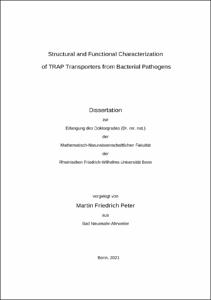Structural and functional characterization of TRAP transporters from bacterial pathogens

Structural and functional characterization of TRAP transporters from bacterial pathogens

| dc.contributor.advisor | Hagelüken, Gregor | |
| dc.contributor.author | Peter, Martin Friedrich | |
| dc.date.accessioned | 2021-08-26T13:37:58Z | |
| dc.date.available | 2022-09-01T22:00:16Z | |
| dc.date.issued | 26.08.2021 | |
| dc.identifier.uri | https://hdl.handle.net/20.500.11811/9282 | |
| dc.description.abstract | The class of tripartite ATP-independent periplasmic (TRAP) transporter proteins are wide-spread in the kingdoms of prokaryotes and archaea, where they are responsible for translo-cation of substrates across the cell membrane. The three components are a periplasmic sub-strate-binding protein (SBP), also referred as P-domain, and two integral membrane pro-teins, a smaller Q-domain and a larger M-domain. The two most extensively studied TRAP transporters HiSiaPQM and VcSiaPQM from the pathogens Haemophilus influenzae and Vibrio cholerae are known as the sole pathway for the uptake of the sugar sialic acid into these bacteria. For both organisms, sialic acid is of key importance for their virulence and helps the bacteria to circumvent the immune response of the host. Since neither of the two bacteria can produce sialic acid by itself, the uptake mechanism is essential. Therefore, TRAP transporters are potential targets for antibiotics, especially because they are absent from eukaryotic cells. However, the entire structure and function of TRAP transporter proteins are still unknown, which hampers the efficient development of compounds that inhibit the uptake of sialic acid. In this work, it was attempted to investigate structural and functional aspects of TRAP transporters with an integrative structural biology approach. In the beginning, two integra-tive methods, namely PELDOR (pulsed electron electron double resonance) and smFRET (single molecule Förster resonance energy transfer) spectroscopy, were compared using three protein model systems. The cross-validation revealed an overall good agreement be-tween these two methods and demonstrated the distinct experimental strengths and ad-vantages of each method. In a next step, both methods were employed to address func-tional aspects of the uptake mechanism from TRAP transporters. In addition to other find-ings, smFRET confirmed the substrate-induced conformational change of TRAP SBPs upon substrate binding. Furthermore, the substrate bound crystal structure of VcSiaP was successfully solved for the first time, which subsequently allowed a comprehensive analy-sis of the protein-substrate interaction. A complex water network between protein and substrate was described and binding studies as well as additional crystal structures con-taining selected residue mutations revealed a high impact of the water network onto the substrate binding process. For the membrane proteins of TRAP transporters, an efficient expression and purification protocol was developed by using various membrane mimetic systems. The proteins were reconstituted into different kinds of nanodiscs which for the first time allowed their han-dling in aqueous solution in a native-like lipid environment. Next, the membrane proteins were prepared and selectively labelled for functional studies by PELDOR spectroscopy. However, due to the yet unknown structures of the transmembrane Q- and M-domains, the PELDOR spectroscopy yielded only limited insight into the structure-function correla-tion of the studied transporter protein. Thus, the subsequent experiments were focused on the structural elucidation of the TRAP transporter membrane proteins using a two-pronged methodical approach, consisting of X-ray crystallography and cryo-electron microscopy. To cope with the difficulties, which still currently exist for the structure determination of membrane proteins, TRAP transporter specific and high affinity nanobodies were success-fully generated. Even though the protein structure could still not be solved on an atomic scale, this work for the first time visualized TRAP transporter membrane domains at low resolutions with cryo-EM. Major necessary steps have been accomplished through this work and pave the way for a full structural description of TRAP transporters in subsequent studies. In addition, in vivo studies were performed to investigate the effect of nanobody binding on the function of the TRAP transporter HiSiaPQM. The presence of several different types of nanobodies showed an inhibiting effect on uptake of sialic acid into the cells. This sets the path for a new class of TRAP transporter inhibitors which represent a promising starting point for the development of therapeutic strategies against the pathogenic bacteria Haemophilus influenzae. | en |
| dc.language.iso | eng | |
| dc.rights | In Copyright | |
| dc.rights.uri | http://rightsstatements.org/vocab/InC/1.0/ | |
| dc.subject | Membranproteine | |
| dc.subject | Pathogene | |
| dc.subject | Proteinstrukturaufklärung | |
| dc.subject | TRAP transporter | |
| dc.subject | Integrative Struktubiologie | |
| dc.subject | membrane proteins | |
| dc.subject | pathogens | |
| dc.subject | protein structure determinatio | |
| dc.subject | integrative structural biology | |
| dc.subject.ddc | 500 Naturwissenschaften | |
| dc.title | Structural and functional characterization of TRAP transporters from bacterial pathogens | |
| dc.type | Dissertation oder Habilitation | |
| dc.publisher.name | Universitäts- und Landesbibliothek Bonn | |
| dc.publisher.location | Bonn | |
| dc.rights.accessRights | openAccess | |
| dc.identifier.urn | https://nbn-resolving.org/urn:nbn:de:hbz:5-63637 | |
| ulbbn.pubtype | Erstveröffentlichung | |
| ulbbnediss.affiliation.name | Rheinische Friedrich-Wilhelms-Universität Bonn | |
| ulbbnediss.affiliation.location | Bonn | |
| ulbbnediss.thesis.level | Dissertation | |
| ulbbnediss.dissID | 6363 | |
| ulbbnediss.date.accepted | 20.08.2021 | |
| ulbbnediss.institute | Mathematisch-Naturwissenschaftliche Fakultät : Fachgruppe Chemie / Institut für Physikalische und Theoretische Chemie | |
| ulbbnediss.fakultaet | Mathematisch-Naturwissenschaftliche Fakultät | |
| dc.contributor.coReferee | Kubitscheck, Ulrich | |
| ulbbnediss.contributor.orcid | https://orcid.org/0000-0001-6549-8127 | |
| ulbbnediss.date.embargoEndDate | 01.09.2022 | |
| ulbbnediss.contributor.gnd | 124913319X |
Files in this item
This item appears in the following Collection(s)
-
E-Dissertationen (4077)




